Pumping Station Desing - Second Edition by Robert L. Sanks, George Tchobahoglous, Garr M. Jones
Подождите немного. Документ загружается.

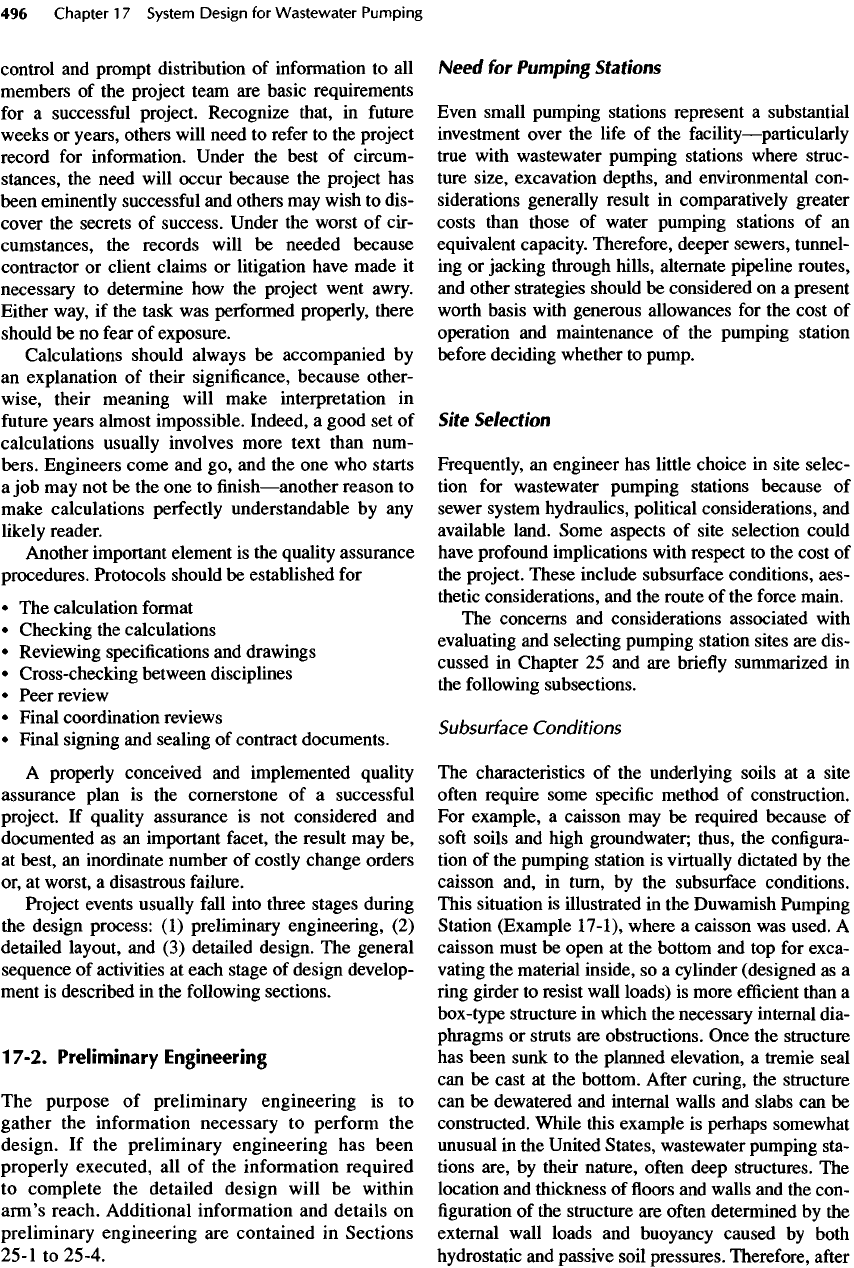
control
and
prompt distribution
of
information
to all
members
of the
project team
are
basic requirements
for
a
successful
project. Recognize that,
in
future
weeks
or
years, others will need
to
refer
to the
project
record
for
information. Under
the
best
of
circum-
stances,
the
need will occur because
the
project
has
been eminently
successful
and
others
may
wish
to
dis-
cover
the
secrets
of
success.
Under
the
worst
of
cir-
cumstances,
the
records will
be
needed because
contractor
or
client claims
or
litigation have made
it
necessary
to
determine
how the
project went awry.
Either way,
if the
task
was
performed properly, there
should
be no
fear
of
exposure.
Calculations should always
be
accompanied
by
an
explanation
of
their significance, because other-
wise, their meaning will make interpretation
in
future
years almost impossible. Indeed,
a
good
set of
calculations
usually involves more text than num-
bers.
Engineers come
and go, and the one who
starts
a job may not be the one to finish
—
another
reason
to
make calculations perfectly understandable
by any
likely reader.
Another important element
is the
quality assurance
procedures. Protocols should
be
established
for
• The
calculation
format
•
Checking
the
calculations
•
Reviewing specifications
and
drawings
•
Cross-checking between
disciplines
•
Peer review
•
Final coordination reviews
•
Final signing
and
sealing
of
contract documents.
A
properly conceived
and
implemented quality
assurance plan
is the
cornerstone
of a
successful
project.
If
quality assurance
is not
considered
and
documented
as an
important
facet,
the
result
may be,
at
best,
an
inordinate number
of
costly change
orders
or, at
worst,
a
disastrous
failure.
Project
events usually
fall
into three
stages
during
the
design process:
(1)
preliminary engineering,
(2)
detailed layout,
and (3)
detailed design.
The
general
sequence
of
activities
at
each stage
of
design develop-
ment
is
described
in the
following
sections.
1
7-2.
Preliminary Engineering
The
purpose
of
preliminary engineering
is to
gather
the
information necessary
to
perform
the
design.
If the
preliminary engineering
has
been
properly executed,
all of the
information required
to
complete
the
detailed
design
will
be
within
arm's reach. Additional information
and
details
on
preliminary
engineering
are
contained
in
Sections
25-1
to
25-4.
Need
for
Pumping
Stations
Even
small pumping stations represent
a
substantial
investment
over
the
life
of the
facility
—
particularly
true
with wastewater pumping stations where struc-
ture
size, excavation depths,
and
environmental con-
siderations generally result
in
comparatively greater
costs than those
of
water pumping stations
of an
equivalent
capacity. Therefore, deeper sewers, tunnel-
ing
or
jacking through hills, alternate pipeline routes,
and
other strategies should
be
considered
on a
present
worth
basis with generous allowances
for the
cost
of
operation
and
maintenance
of the
pumping station
before
deciding whether
to
pump.
5ft
e
Selection
Frequently,
an
engineer
has
little choice
in
site selec-
tion
for
wastewater pumping stations because
of
sewer system hydraulics, political considerations,
and
available land. Some aspects
of
site selection could
have
profound implications with respect
to the
cost
of
the
project. These include subsurface conditions, aes-
thetic considerations,
and the
route
of the
force main.
The
concerns
and
considerations associated with
evaluating
and
selecting pumping station sites
are
dis-
cussed
in
Chapter
25 and are
briefly
summarized
in
the
following subsections.
Subsurface
Conditions
The
characteristics
of the
underlying soils
at a
site
often
require some
specific
method
of
construction.
For
example,
a
caisson
may be
required because
of
soft
soils
and
high
ground
water;
thus,
the
configura-
tion
of the
pumping station
is
virtually dictated
by the
caisson and,
in
turn,
by the
subsurface conditions.
This
situation
is
illustrated
in the
Duwamish
Pumping
Station (Example 17-1), where
a
caisson
was
used.
A
caisson must
be
open
at the
bottom
and top for
exca-
vating
the
material inside,
so a
cylinder (designed
as a
ring girder
to
resist wall loads)
is
more
efficient
than
a
box-type structure
in
which
the
necessary internal dia-
phragms
or
struts
are
obstructions. Once
the
structure
has
been sunk
to the
planned elevation,
a
tremie
seal
can be
cast
at the
bottom.
After
curing,
the
structure
can
be
dewatered
and
internal walls
and
slabs
can be
constructed. While this example
is
perhaps somewhat
unusual
in the
United States, wastewater pumping sta-
tions are,
by
their nature,
often
deep structures.
The
location
and
thickness
of floors and
walls
and the
con-
figuration
of
the
structure
are
often
determined
by the
external wall loads
and
buoyancy caused
by
both
hydrostatic
and
passive soil pressures. Therefore,
after
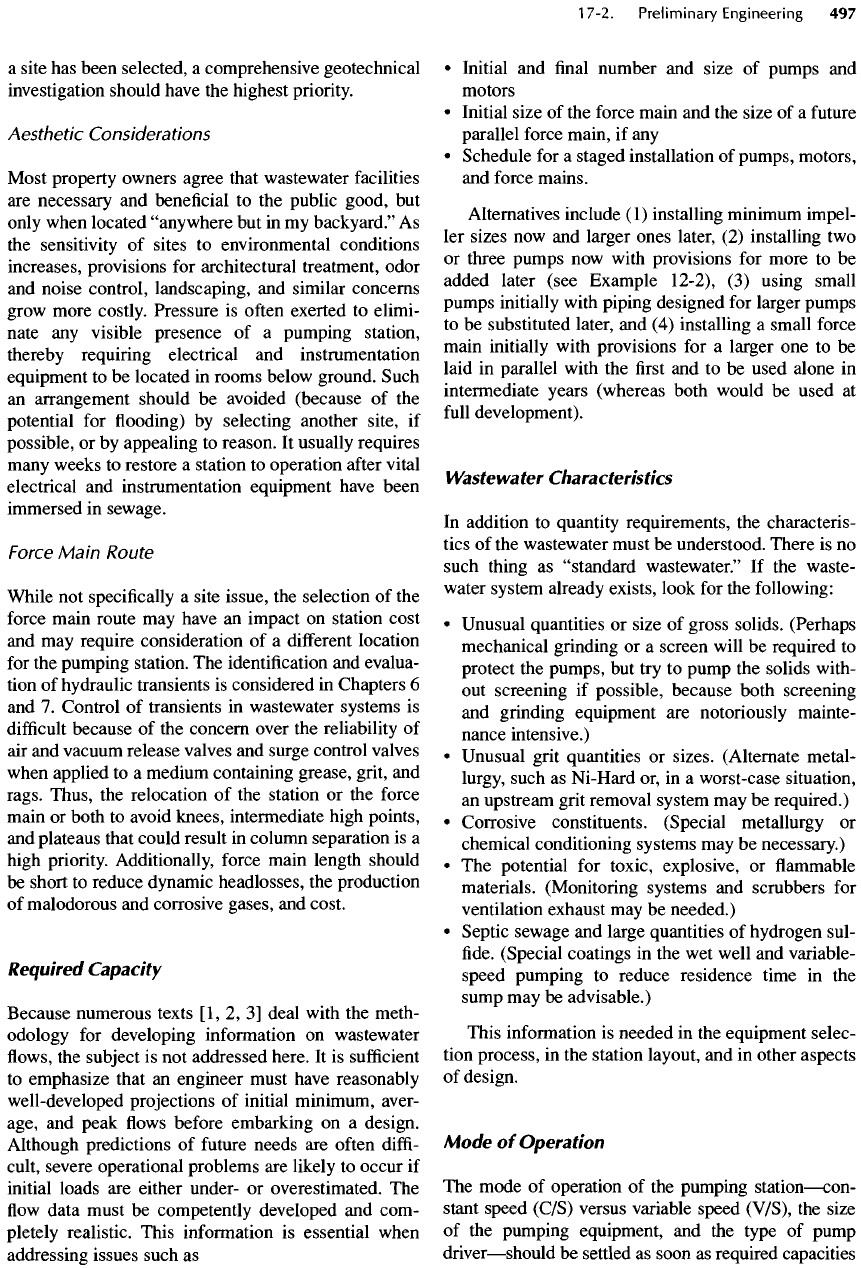
a
site
has
been selected,
a
comprehensive geotechnical
investigation
should have
the
highest priority.
Aesthetic
Considerations
Most property owners agree that wastewater facilities
are
necessary
and
beneficial
to the
public good,
but
only
when located
"anywhere
but in my
backyard."
As
the
sensitivity
of
sites
to
environmental conditions
increases, provisions
for
architectural treatment, odor
and
noise
control, landscaping,
and
similar concerns
grow
more costly.
Pressure
is
often
exerted
to
elimi-
nate
any
visible presence
of a
pumping station,
thereby requiring electrical
and
instrumentation
equipment
to be
located
in
rooms below ground. Such
an
arrangement should
be
avoided (because
of the
potential
for
flooding)
by
selecting another site,
if
possible,
or by
appealing
to
reason.
It
usually requires
many
weeks
to
restore
a
station
to
operation
after
vital
electrical
and
instrumentation equipment have been
immersed
in
sewage.
Force
Main
Route
While
not
specifically
a
site issue,
the
selection
of the
force
main route
may
have
an
impact
on
station cost
and may
require consideration
of a
different
location
for
the
pumping station.
The
identification
and
evalua-
tion
of
hydraulic transients
is
considered
in
Chapters
6
and 7.
Control
of
transients
in
wastewater systems
is
difficult
because
of the
concern over
the
reliability
of
air and
vacuum
release
valves
and
surge control valves
when
applied
to a
medium containing grease, grit,
and
rags. Thus,
the
relocation
of the
station
or the
force
main
or
both
to
avoid knees, intermediate high points,
and
plateaus that could result
in
column separation
is a
high
priority. Additionally,
force
main length should
be
short
to
reduce dynamic headlosses,
the
production
of
malodorous
and
corrosive gases,
and
cost.
Required
Capacity
Because numerous texts
[1,
2, 3]
deal with
the
meth-
odology
for
developing information
on
wastewater
flows, the
subject
is not
addressed here.
It is
sufficient
to
emphasize that
an
engineer must have reasonably
well-developed projections
of
initial minimum, aver-
age,
and
peak
flows
before embarking
on a
design.
Although
predictions
of
future
needs
are
often
diffi-
cult,
severe operational problems
are
likely
to
occur
if
initial loads
are
either under-
or
overestimated.
The
flow
data must
be
competently developed
and
com-
pletely realistic. This information
is
essential when
addressing issues such
as
•
Initial
and final
number
and
size
of
pumps
and
motors
•
Initial size
of the
force main
and the
size
of a
future
parallel
force
main,
if any
•
Schedule
for a
staged installation
of
pumps, motors,
and
force mains.
Alternatives include
(1)
installing minimum impel-
ler
sizes
now and
larger ones later,
(2)
installing
two
or
three pumps
now
with provisions
for
more
to be
added later (see Example 12-2),
(3)
using small
pumps
initially with piping designed
for
larger pumps
to be
substituted later,
and (4)
installing
a
small force
main initially with provisions
for a
larger
one to be
laid
in
parallel with
the first and to be
used alone
in
intermediate years (whereas both would
be
used
at
full
development).
Wastewater
Characteristics
In
addition
to
quantity requirements,
the
characteris-
tics
of the
wastewater must
be
understood.
There
is no
such
thing
as
"standard
wastewater."
If the
waste-
water system already exists, look
for the
following:
•
Unusual quantities
or
size
of
gross solids. (Perhaps
mechanical grinding
or a
screen will
be
required
to
protect
the
pumps,
but try to
pump
the
solids with-
out
screening
if
possible, because both screening
and
grinding equipment
are
notoriously mainte-
nance intensive.)
•
Unusual grit quantities
or
sizes. (Alternate metal-
lurgy,
such
as
Ni-Hard
or, in a
worst-case situation,
an
upstream grit removal system
may be
required.)
•
Corrosive constituents. (Special metallurgy
or
chemical conditioning systems
may be
necessary.)
• The
potential
for
toxic, explosive,
or flammable
materials. (Monitoring systems
and
scrubbers
for
ventilation exhaust
may be
needed.)
•
Septic sewage
and
large quantities
of
hydrogen
sul-
fide.
(Special coatings
in the wet
well
and
variable-
speed
pumping
to
reduce
residence
time
in the
sump
may be
advisable.)
This information
is
needed
in the
equipment selec-
tion process,
in the
station layout,
and in
other aspects
of
design.
Mode
of
Operation
The
mode
of
operation
of the
pumping
station
—
con-
stant
speed (C/S) versus variable speed (V/S),
the
size
of
the
pumping equipment,
and the
type
of
pump
driver
—
should
be
settled
as
soon
as
required capacities
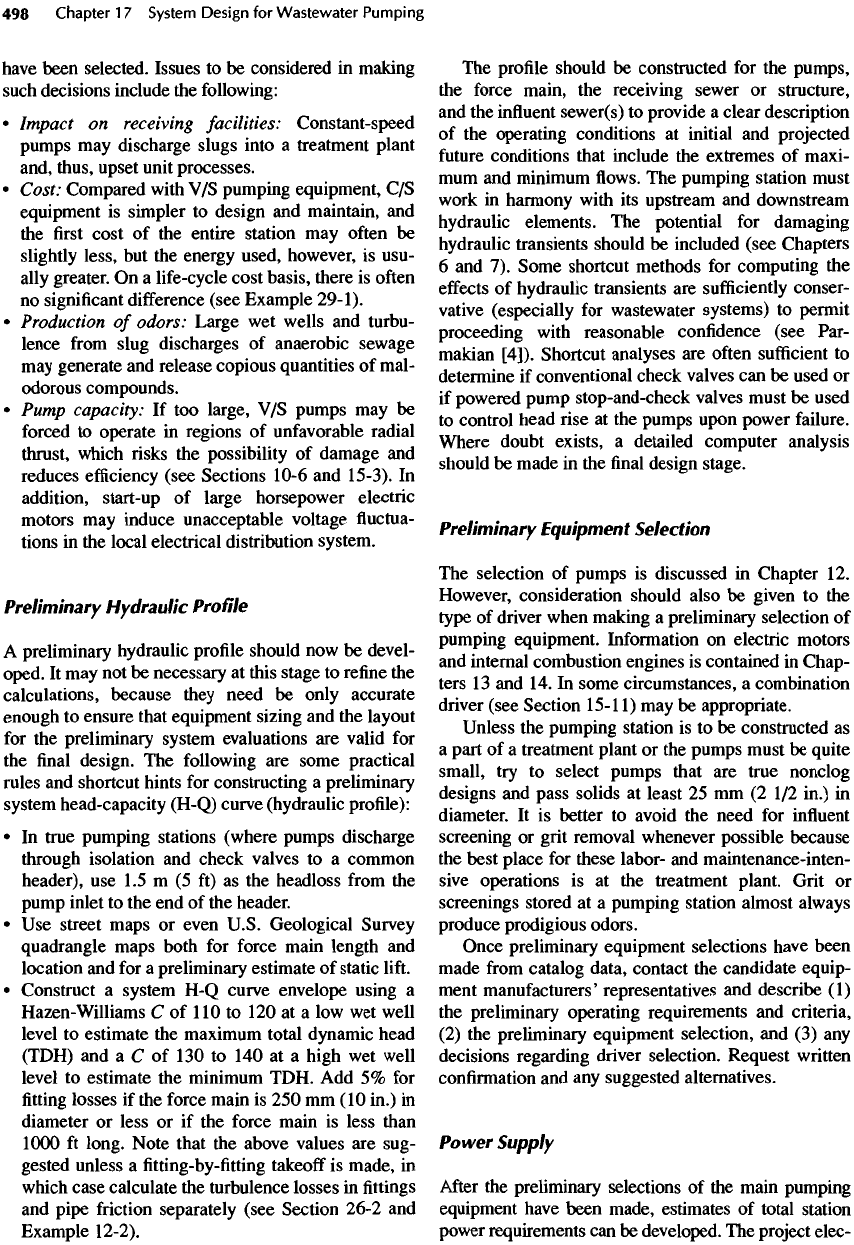
have
been
selected.
Issues
to be
considered
in
making
such
decisions include
the
following:
•
Impact
on
receiving
facilities: Constant-speed
pumps
may
discharge slugs into
a
treatment plant
and, thus, upset unit
processes.
•
Cost
:
Compared with
V/S
pumping equipment,
C/S
equipment
is
simpler
to
design
and
maintain,
and
the first
cost
of the
entire station
may
often
be
slightly less,
but the
energy used, however,
is
usu-
ally
greater.
On a
life-cycle cost basis, there
is
often
no
significant
difference
(see Example
29-1).
•
Production
of
odors:
Large
wet
wells
and
turbu-
lence
from
slug discharges
of
anaerobic sewage
may
generate
and
release
copious quantities
of
mal-
odorous compounds.
•
Pump
capacity:
If too
large,
V/S
pumps
may be
forced
to
operate
in
regions
of
unfavorable radial
thrust,
which risks
the
possibility
of
damage
and
reduces
efficiency
(see Sections 10-6
and
15-3).
In
addition, start-up
of
large horsepower
electric
motors
may
induce unacceptable voltage
fluctua-
tions
in the
local
electrical distribution system.
Preliminary
Hydraulic
Profile
A
preliminary hydraulic
profile
should
now be
devel-
oped.
It may not be
necessary
at
this stage
to
refine
the
calculations, because they need
be
only accurate
enough
to
ensure that equipment sizing
and the
layout
for
the
preliminary system evaluations
are
valid
for
the
final
design.
The
following
are
some practical
rules
and
shortcut hints
for
constructing
a
preliminary
system
head-capacity (H-Q) curve (hydraulic profile):
• In
true pumping stations (where pumps discharge
through isolation
and
check valves
to a
common
header),
use 1.5
m
(5 ft) as the
headless
from
the
pump
inlet
to the end of the
header.
• Use
street maps
or
even U.S. Geological Survey
quadrangle maps both
for
force main length
and
location
and for a
preliminary estimate
of
static
lift.
•
Construct
a
system
H-Q
curve envelope using
a
Hazen-
Williams
C of 110 to 120 at a low wet
well
level
to
estimate
the
maximum
total
dynamic head
(TDH)
and a C of 130 to 140 at a
high
wet
well
level
to
estimate
the
minimum TDH.
Add 5% for
fitting
losses
if the
force
main
is 250 mm
(10
in.)
in
diameter
or
less
or if the
force main
is
less than
1000
ft
long. Note that
the
above values
are
sug-
gested unless
a fitting-by-fitting
takeoff
is
made,
in
which case calculate
the
turbulence
losses
in fittings
and
pipe
friction
separately (see Section 26-2
and
Example 12-2).
The
profile should
be
constructed
for the
pumps,
the
force main,
the
receiving sewer
or
structure,
and
the
influent
sewer(s)
to
provide
a
clear description
of
the
operating conditions
at
initial
and
projected
future
conditions that include
the
extremes
of
maxi-
mum
and
minimum
flows. The
pumping station must
work
in
harmony with
its
upstream
and
downstream
hydraulic
elements.
The
potential
for
damaging
hydraulic transients should
be
included (see Chapters
6 and 7).
Some shortcut methods
for
computing
the
effects
of
hydraulic transients
are
sufficiently
conser-
vative
(especially
for
wastewater systems)
to
permit
proceeding with reasonable confidence (see Par-
makian
[4]).
Shortcut analyses
are
often
sufficient
to
determine
if
conventional check valves
can be
used
or
if
powered pump stop-and-check valves must
be
used
to
control head
rise at the
pumps upon power failure.
Where doubt exists,
a
detailed computer analysis
should
be
made
in the final
design stage.
Preliminary
Equipment
Selection
The
selection
of
pumps
is
discussed
in
Chapter
12.
However, consideration should also
be
given
to the
type
of
driver when making
a
preliminary selection
of
pumping equipment. Information
on
electric motors
and
internal combustion engines
is
contained
in
Chap-
ters
13
and 14. In
some circumstances,
a
combination
driver (see
Section
15-11)
may be
appropriate.
Unless
the
pumping station
is to be
constructed
as
a
part
of a
treatment plant
or the
pumps must
be
quite
small,
try to
select
pumps that
are
true nonclog
designs
and
pass solids
at
least
25 mm (2 1/2
in.)
in
diameter.
It is
better
to
avoid
the
need
for
influent
screening
or
grit removal whenever possible because
the
best
place
for
these labor-
and
maintenance-inten-
sive operations
is at the
treatment plant. Grit
or
screenings stored
at a
pumping station almost always
produce prodigious odors.
Once preliminary equipment selections have been
made
from
catalog data, contact
the
candidate equip-
ment
manufacturers' representatives
and
describe
(1)
the
preliminary operating requirements
and
criteria,
(2)
the
preliminary equipment selection,
and (3) any
decisions regarding driver selection. Request written
confirmation
and any
suggested alternatives.
Power
Supply
After
the
preliminary
selections
of the
main pumping
equipment have been made, estimates
of
total station
power requirements
can be
developed.
The
project
elec-
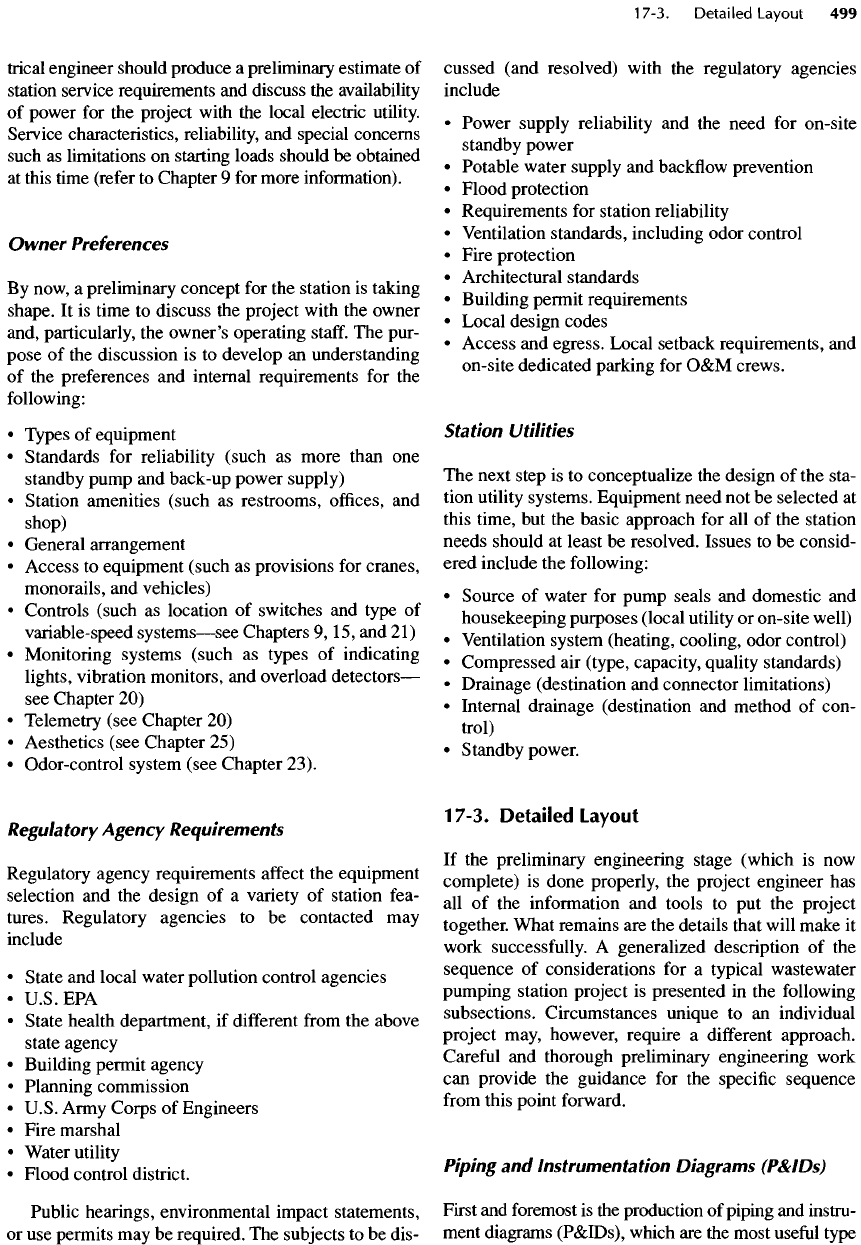
trical
engineer should produce
a
preliminary estimate
of
station service requirements
and
discuss
the
availability
of
power
for the
project with
the
local
electric utility.
Service characteristics, reliability,
and
special concerns
such
as
limitations
on
starting loads should
be
obtained
at
this time
(refer
to
Chapter
9 for
more information).
Owner
Preferences
By
now,
a
preliminary concept
for the
station
is
taking
shape.
It is
time
to
discuss
the
project with
the
owner
and, particularly,
the
owner's operating
staff.
The
pur-
pose
of the
discussion
is to
develop
an
understanding
of
the
preferences
and
internal requirements
for the
following:
•
Types
of
equipment
•
Standards
for
reliability (such
as
more than
one
standby
pump
and
back-up power supply)
•
Station amenities
(such
as
restrooms,
offices,
and
shop)
•
General arrangement
•
Access
to
equipment (such
as
provisions
for
cranes,
monorails,
and
vehicles)
•
Controls (such
as
location
of
switches
and
type
of
variable-speed
systems
—
see
Chapters
9,
15,
and
21)
•
Monitoring systems (such
as
types
of
indicating
lights, vibration monitors,
and
overload
detectors
—
see
Chapter
20)
•
Telemetry (see Chapter
20)
•
Aesthetics (see Chapter
25)
•
Odor-control system (see Chapter 23).
Regulatory
Agency Requirements
Regulatory
agency requirements
affect
the
equipment
selection
and the
design
of a
variety
of
station fea-
tures. Regulatory agencies
to be
contacted
may
include
•
State
and
local water pollution control agencies
•
U.S.
EPA
•
State health department,
if
different
from
the
above
state agency
•
Building permit agency
•
Planning commission
•
U.S.
Army Corps
of
Engineers
•
Fire marshal
•
Water utility
•
Flood control district.
Public hearings, environmental impact statements,
or
use
permits
may be
required.
The
subjects
to be
dis-
cussed (and resolved) with
the
regulatory agencies
include
•
Power supply reliability
and the
need
for
on-site
standby
power
•
Potable
water supply
and
backflow
prevention
•
Flood
protection
•
Requirements
for
station reliability
•
Ventilation standards, including odor control
•
Fire
protection
•
Architectural standards
•
Building permit requirements
•
Local
design
codes
•
Access
and
egress.
Local setback requirements,
and
on-site dedicated parking
for O&M
crews.
Station
Utilities
The
next step
is to
conceptualize
the
design
of the
sta-
tion utility systems. Equipment need
not be
selected
at
this time,
but the
basic approach
for all of the
station
needs should
at
least
be
resolved. Issues
to be
consid-
ered include
the
following:
•
Source
of
water
for
pump
seals
and
domestic
and
housekeeping purposes (local utility
or
on-site well)
•
Ventilation system (heating, cooling, odor control)
•
Compressed
air
(type, capacity, quality standards)
•
Drainage (destination
and
connector limitations)
•
Internal drainage (destination
and
method
of
con-
trol)
•
Standby power.
17-3. Detailed
Layout
If
the
preliminary engineering stage (which
is now
complete)
is
done properly,
the
project engineer
has
all of the
information
and
tools
to put the
project
together. What remains
are the
details that will make
it
work
successfully.
A
generalized description
of the
sequence
of
considerations
for a
typical wastewater
pumping
station project
is
presented
in the
following
subsections. Circumstances unique
to an
individual
project
may, however, require
a
different
approach.
Careful
and
thorough preliminary engineering work
can
provide
the
guidance
for the
specific
sequence
from
this point forward.
Piping
and
Instrumentation
Diagrams
(P&IDs)
First
and
foremost
is the
production
of
piping
and
instru-
ment
diagrams (P&IDs), which
are the
most
useful
type
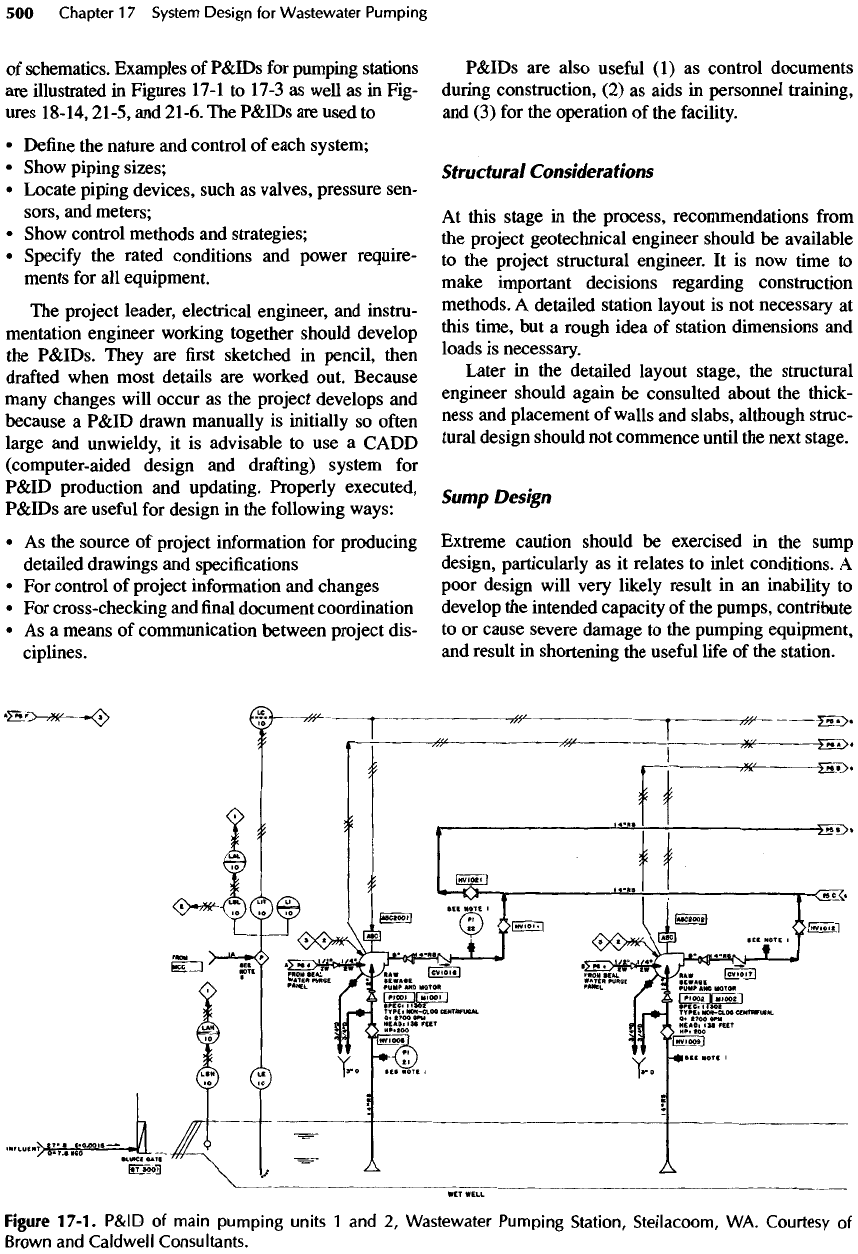
of
schematics. Examples
of
P&IDs
for
pumping stations
are
illustrated
in
Figures 17-1
to
17-3
as
well
as in
Fig-
ures
18-14,
21-5,
and
21-6.
The
P&IDs
are
used
to
•
Define
the
nature
and
control
of
each system;
•
Show piping sizes;
•
Locate
piping devices, such
as
valves,
pressure
sen-
sors,
and
meters;
•
Show control methods
and
strategies;
•
Specify
the
rated conditions
and
power require-
ments
for all
equipment.
The
project leader, electrical engineer,
and
instru-
mentation engineer working together should develop
the
P&IDs. They
are first
sketched
in
pencil, then
drafted
when most details
are
worked out. Because
many
changes will occur
as the
project develops
and
because
a
P&ID
drawn
manually
is
initially
so
often
large
and
unwieldy,
it is
advisable
to use a
CADD
(computer-aided design
and
drafting)
system
for
P&ID production
and
updating. Properly executed,
P&IDs
are
useful
for
design
in the
following ways:
• As the
source
of
project information
for
producing
detailed drawings
and
specifications
• For
control
of
project information
and
changes
• For
cross-checking
and final
document coordination
• As a
means
of
communication between project dis-
ciplines.
P&IDs
are
also
useful
(1) as
control documents
during
construction,
(2) as
aids
in
personnel training,
and
(3) for the
operation
of the
facility.
Structural
Considerations
At
this stage
in the
process,
recommendations
from
the
project
geotechnical
engineer should
be
available
to the
project structural engineer.
It is now
time
to
make
important decisions regarding construction
methods.
A
detailed station layout
is not
necessary
at
this time,
but a
rough idea
of
station dimensions
and
loads
is
necessary.
Later
in the
detailed layout stage,
the
structural
engineer should again
be
consulted about
the
thick-
ness
and
placement
of
walls
and
slabs, although struc-
tural
design should
not
commence
until
the
next stage.
Sump
Design
Extreme caution should
be
exercised
in the
sump
design, particularly
as it
relates
to
inlet conditions.
A
poor
design will very likely result
in an
inability
to
develop
the
intended capacity
of the
pumps, contribute
to
or
cause severe damage
to the
pumping equipment,
and
result
in
shortening
the
useful
life
of the
station.
Figure
17-1.
P&ID
of
main
pumping
units
1 and 2,
Wastewater
Pumping
Station,
Steilacoom,
WA.
Courtesy
of
Brown
and
Caldwell
Consultants.
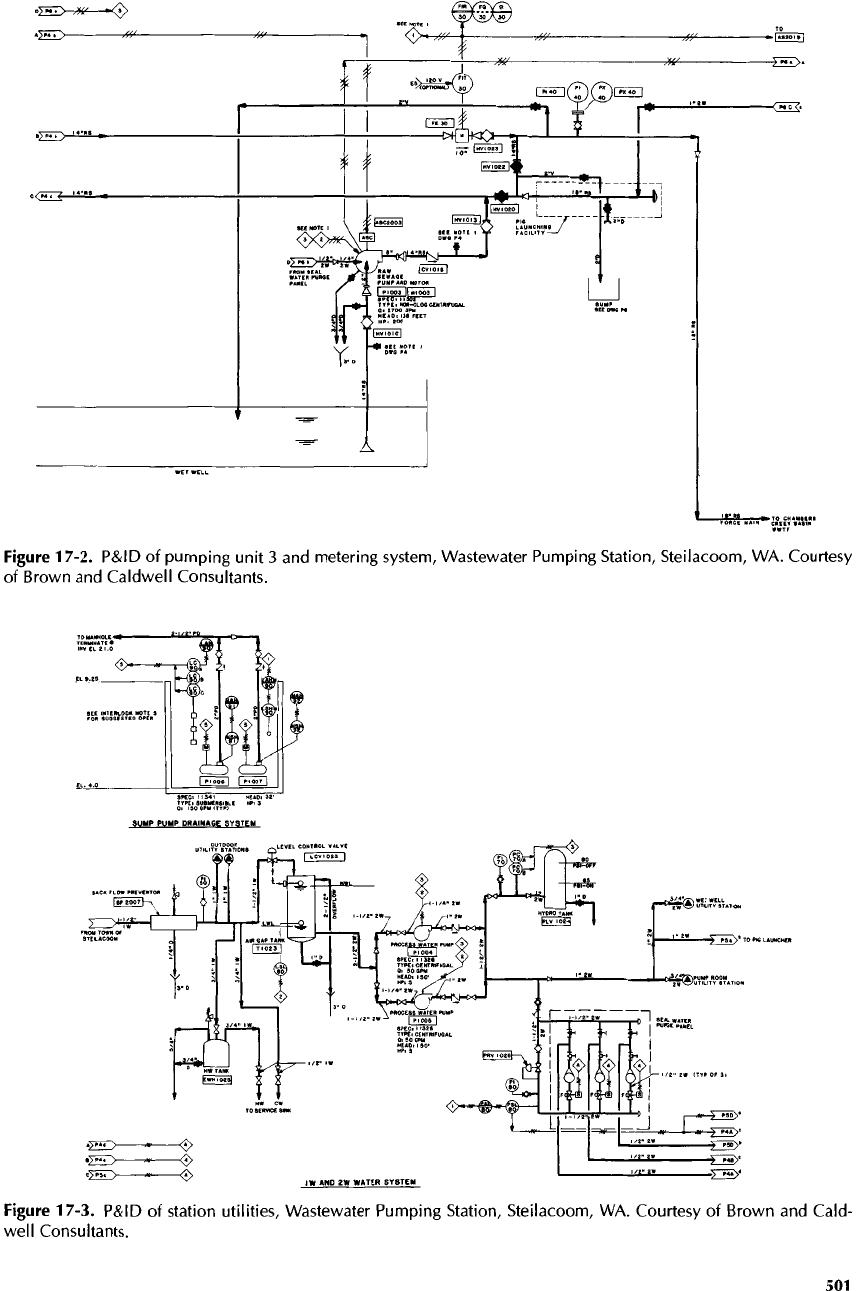
Figure
17-2.
P&ID
of
pumping
unit
3 and
metering
system,
Wastewater Pumping Station, Steilacoom,
WA.
Courtesy
of
Brown
and
Caldwell Consultants.
Figure
17-3. P&ID
of
station
utilities,
Wastewater Pumping Station, Steilacoom,
WA.
Courtesy
of
Brown
and
Cald-
well
Consultants.
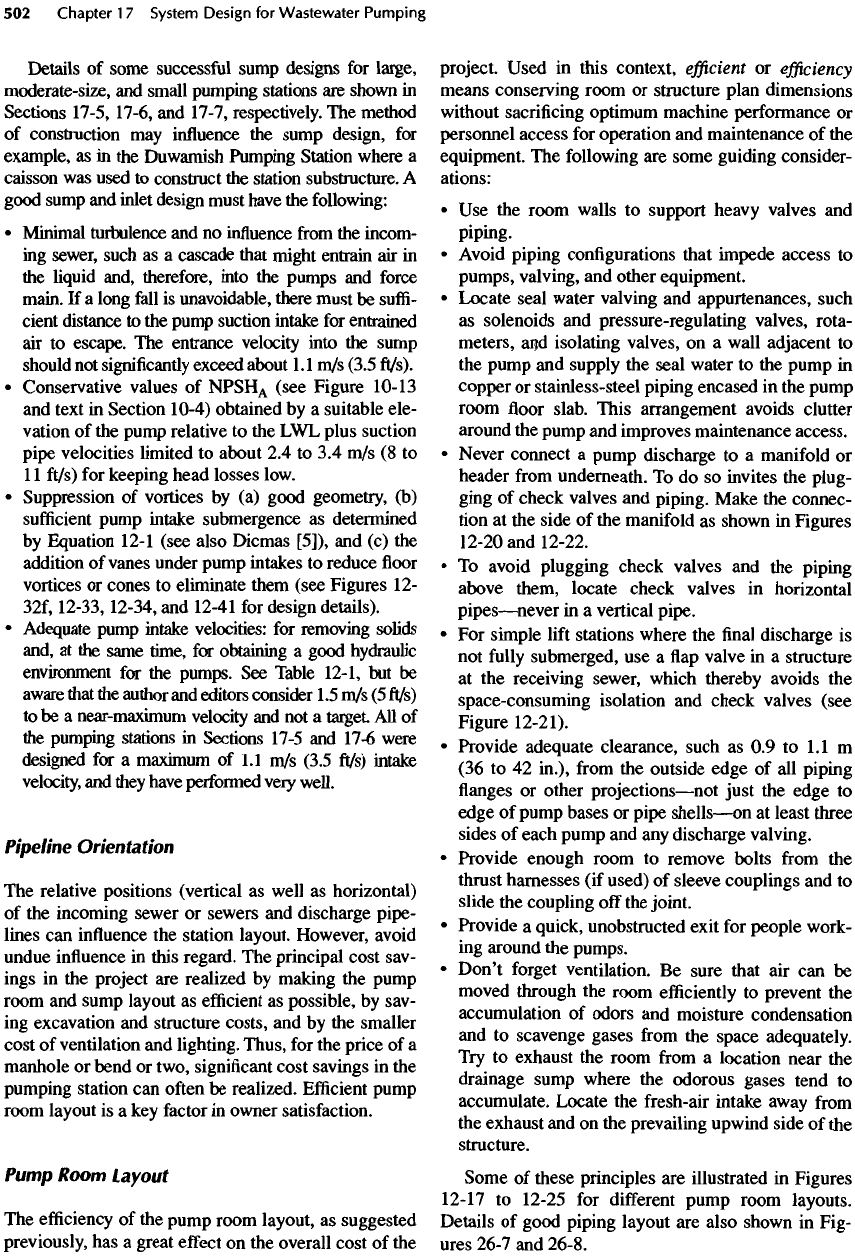
Details
of
some successful sump
designs
for
large,
moderate-size,
and
small pumping stations
are
shown
in
Sections
17-5,
17-6,
and
17-7, respectively.
The
method
of
construction
may
influence
the
sump design,
for
example,
as in the
Duwamish
Pumping Station where
a
caisson
was
used
to
construct
the
station substructure.
A
good sump
and
inlet design must have
the
following:
•
Minimal turbulence
and no
influence
from
the
incom-
ing
sewer, such
as a
cascade that might entrain
air in
the
liquid and, therefore, into
the
pumps
and
force
main.
If a
long
fall
is
unavoidable, there must
be
suffi-
cient distance
to the
pump suction intake
for
entrained
air
to
escape.
Hie
entrance velocity into
the
sump
should
not
significantly
exceed about
1
.
1
m/s
(3.5
ft/s).
•
Conservative values
of
NPSH
A
(see
Figure
10-13
and
text
in
Section 10-4) obtained
by a
suitable ele-
vation
of the
pump relative
to the LWL
plus suction
pipe velocities limited
to
about
2.4 to 3.4 m/s (8 to
1
1
ft/s)
for
keeping head losses low.
•
Suppression
of
vortices
by (a)
good geometry,
(b)
sufficient
pump intake submergence
as
determined
by
Equation 12-1 (see also
Dicmas
[5]),
and (c) the
addition
of
vanes under pump intakes
to
reduce
floor
vortices
or
cones
to
eliminate them (see Figures
12-
32f,
12-33, 12-34,
and
12-41
for
design details).
•
Adequate pump intake velocities:
for
removing solids
and,
at the
same
time, for
obtaining
a
good hydraulic
environment
for the
pumps.
See
Table 12-1,
but be
aware
that
the
author
and
editors consider
1
.5
m/s
(5 ft/s)
to
be a
near-maximum
velocity
and not a
target.
All of
the
pumping stations
in
Sections 17-5
and
17-6
were
designed
for a
maximum
of 1.1
m/s
(3.5
ft/s)
intake
velocity,
and
they
have
performed
very
well.
Pipeline
Orientation
The
relative
positions
(vertical
as
well
as
horizontal)
of
the
incoming sewer
or
sewers
and
discharge pipe-
lines
can
influence
the
station layout. However, avoid
undue
influence
in
this regard.
The
principal cost sav-
ings
in the
project
are
realized
by
making
the
pump
room
and
sump layout
as
efficient
as
possible,
by
sav-
ing
excavation
and
structure
costs,
and by the
smaller
cost
of
ventilation
and
lighting. Thus,
for the
price
of a
manhole
or
bend
or
two,
significant
cost savings
in the
pumping
station
can
often
be
realized.
Efficient
pump
room layout
is a key
factor
in
owner satisfaction.
Pump
Room
Layout
The
efficiency
of the
pump room layout,
as
suggested
previously,
has a
great
effect
on the
overall cost
of the
project.
Used
in
this
context,
efficient
or
efficiency
means conserving room
or
structure plan dimensions
without sacrificing optimum machine performance
or
personnel
access
for
operation
and
maintenance
of the
equipment.
The
following
are
some guiding consider-
ations:
• Use the
room walls
to
support heavy valves
and
piping.
•
Avoid piping configurations that impede
access
to
pumps, valving,
and
other equipment.
•
Locate
seal water valving
and
appurtenances, such
as
solenoids
and
pressure-regulating valves, rota-
meters,
and
isolating
valves,
on a
wall adjacent
to
the
pump
and
supply
the
seal
water
to the
pump
in
copper
or
stainless-steel
piping
encased
in the
pump
room
floor
slab. This arrangement avoids clutter
around
the
pump
and
improves maintenance access.
•
Never connect
a
pump discharge
to a
manifold
or
header
from
underneath.
To do so
invites
the
plug-
ging
of
check valves
and
piping. Make
the
connec-
tion
at the
side
of the
manifold
as
shown
in
Figures
12-20
and
12-22.
• To
avoid plugging check valves
and the
piping
above them,
locate
check valves
in
horizontal
pipes
—
never
in a
vertical pipe.
• For
simple
lift
stations where
the final
discharge
is
not
fully
submerged,
use a flap
valve
in a
structure
at
the
receiving sewer, which thereby avoids
the
space-consuming isolation
and
check valves (see
Figure
12-21).
•
Provide adequate clearance, such
as 0.9 to
1.1
m
(36 to 42
in.),
from
the
outside edge
of all
piping
flanges or
other
projections
—
not
just
the
edge
to
edge
of
pump bases
or
pipe
shells
—
on
at
least three
sides
of
each pump
and any
discharge valving.
•
Provide enough room
to
remove bolts
from
the
thrust
harnesses
(if
used)
of
sleeve couplings
and to
slide
the
coupling
off the
joint.
•
Provide
a
quick, unobstructed exit
for
people
work-
ing
around
the
pumps.
•
Don't
forget ventilation.
Be
sure that
air can be
moved through
the
room
efficiently
to
prevent
the
accumulation
of
odors
and
moisture condensation
and
to
scavenge gases
from
the
space adequately.
Try
to
exhaust
the
room
from
a
location near
the
drainage sump where
the
odorous gases tend
to
accumulate. Locate
the
fresh-air intake away
from
the
exhaust
and on the
prevailing upwind
side
of the
structure.
Some
of
these principles
are
illustrated
in
Figures
12-17
to
12-25
for
different
pump room layouts.
Details
of
good piping layout
are
also shown
in
Fig-
ures 26-7
and
26-8.
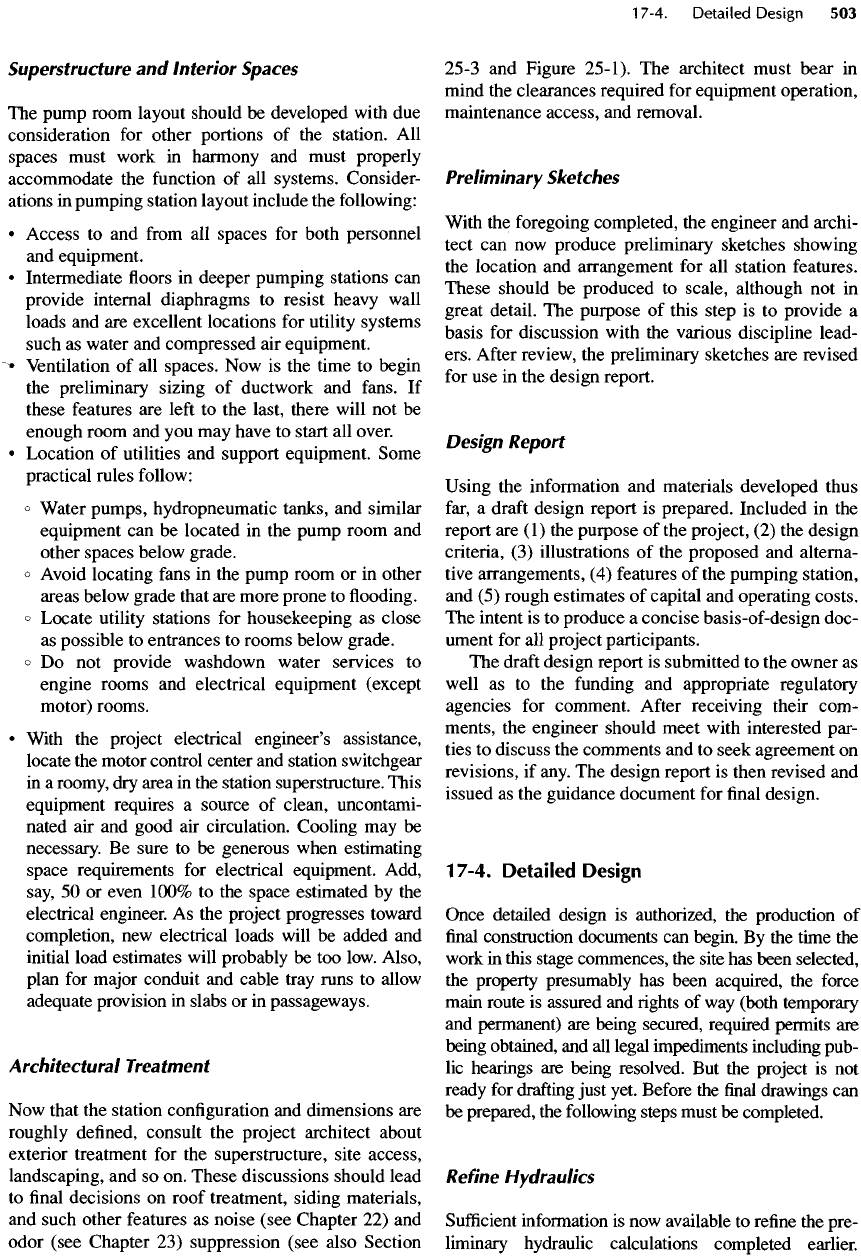
Superstructure
and
Interior
Spaces
The
pump room layout should
be
developed with
due
consideration
for
other portions
of the
station.
All
spaces must work
in
harmony
and
must properly
accommodate
the
function
of all
systems. Consider-
ations
in
pumping station layout include
the
following:
•
Access
to and
from
all
spaces
for
both personnel
and
equipment.
•
Intermediate
floors in
deeper pumping stations
can
provide internal diaphragms
to
resist heavy wall
loads
and are
excellent locations
for
utility systems
such
as
water
and
compressed
air
equipment.
•
Ventilation
of all
spaces.
Now is the
time
to
begin
the
preliminary sizing
of
ductwork
and
fans.
If
these features
are
left
to the
last, there will
not be
enough
room
and you may
have
to
start
all
over.
•
Location
of
utilities
and
support equipment. Some
practical rules
follow:
°
Water pumps, hydropneumatic tanks,
and
similar
equipment
can be
located
in the
pump room
and
other spaces below grade.
°
Avoid locating
fans
in the
pump room
or in
other
areas below grade that
are
more prone
to flooding.
°
Locate utility stations
for
housekeeping
as
close
as
possible
to
entrances
to
rooms below grade.
°
Do not
provide washdown water services
to
engine rooms
and
electrical equipment (except
motor) rooms.
•
With
the
project electrical engineer's assistance,
locate
the
motor control center
and
station
switchgear
in
a
roomy,
dry
area
in the
station superstructure. This
equipment requires
a
source
of
clean,
uncontami-
nated
air and
good
air
circulation. Cooling
may be
necessary.
Be
sure
to be
generous when estimating
space requirements
for
electrical equipment. Add,
say,
50 or
even 100%
to the
space estimated
by the
electrical engineer.
As the
project progresses toward
completion,
new
electrical loads will
be
added
and
initial
load estimates will probably
be too
low. Also,
plan
for
major
conduit
and
cable tray runs
to
allow
adequate provision
in
slabs
or in
passageways.
Architectural
Treatment
Now
that
the
station
configuration
and
dimensions
are
roughly
defined,
consult
the
project architect about
exterior treatment
for the
superstructure, site access,
landscaping,
and so on.
These discussions should lead
to
final
decisions
on
roof treatment, siding materials,
and
such other features
as
noise (see Chapter
22) and
odor (see Chapter
23)
suppression (see also Section
25-3
and
Figure 25-1).
The
architect must bear
in
mind
the
clearances required
for
equipment
operation,
maintenance access,
and
removal.
Preliminary
Sketches
With
the
foregoing
completed,
the
engineer
and
archi-
tect
can now
produce preliminary sketches showing
the
location
and
arrangement
for all
station features.
These
should
be
produced
to
scale,
although
not in
great detail.
The
purpose
of
this step
is to
provide
a
basis
for
discussion with
the
various discipline lead-
ers.
After
review,
the
preliminary sketches
are
revised
for
use in the
design report.
Design
Report
Using
the
information
and
materials developed thus
far,
a
draft
design report
is
prepared. Included
in the
report
are (1) the
purpose
of the
project,
(2) the
design
criteria,
(3)
illustrations
of the
proposed
and
alterna-
tive
arrangements,
(4)
features
of the
pumping station,
and
(5)
rough estimates
of
capital
and
operating costs.
The
intent
is to
produce
a
concise basis-of-design doc-
ument
for all
project participants.
The
draft
design report
is
submitted
to the
owner
as
well
as to the
funding
and
appropriate regulatory
agencies
for
comment.
After
receiving
their
com-
ments,
the
engineer should meet with interested par-
ties
to
discuss
the
comments
and to
seek agreement
on
revisions,
if
any.
The
design report
is
then revised
and
issued
as the
guidance document
for final
design.
1
7-4.
Detailed Design
Once detailed design
is
authorized,
the
production
of
final
construction
documents
can
begin.
By the
time
the
work
in
this stage commences,
the
site
has
been selected,
the
property presumably
has
been acquired,
the
force
main route
is
assured
and rights of way
(both temporary
and
permanent)
are
being secured, required permits
are
being obtained,
and all
legal impediments including pub-
lic
hearings
are
being resolved.
But the
project
is not
ready
for
drafting
just yet.
Before
the final
drawings
can
be
prepared,
the
following
steps must
be
completed.
Refine
Hydraulics
Sufficient
information
is now
available
to
refine
the
pre-
liminary hydraulic calculations completed earlier.
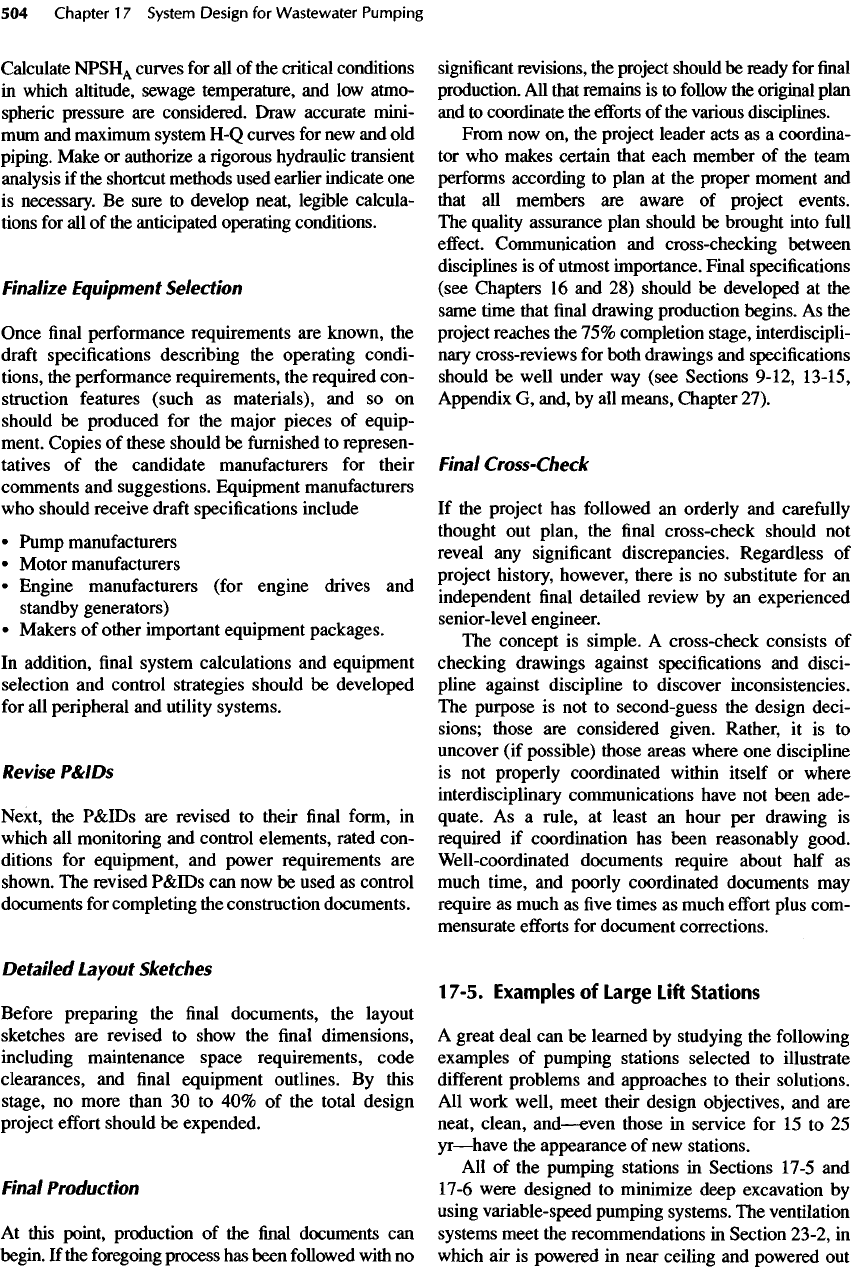
Calculate
NPSH
A
curves
for all of the
critical conditions
in
which altitude, sewage temperature,
and low
atmo-
spheric pressure
are
considered. Draw accurate mini-
mum
and
maximum
system
H-Q
curves
for new and old
piping. Make
or
authorize
a
rigorous hydraulic transient
analysis
if the
shortcut methods used earlier indicate
one
is
necessary.
Be
sure
to
develop neat, legible calcula-
tions
for all of the
anticipated operating conditions.
Finalize
Equipment
Selection
Once
final
performance requirements
are
known,
the
draft
specifications describing
the
operating condi-
tions,
the
performance requirements,
the
required con-
struction features (such
as
materials),
and so on
should
be
produced
for the
major
pieces
of
equip-
ment.
Copies
of
these should
be
furnished
to
represen-
tatives
of the
candidate manufacturers
for
their
comments
and
suggestions. Equipment manufacturers
who
should receive
draft
specifications include
•
Pump manufacturers
•
Motor manufacturers
•
Engine manufacturers (for
engine
drives
and
standby
generators)
•
Makers
of
other important equipment packages.
In
addition,
final
system calculations
and
equipment
selection
and
control strategies should
be
developed
for
all
peripheral
and
utility systems.
Revise
P&IDs
Next,
the
P&IDs
are
revised
to
their
final
form,
in
which
all
monitoring
and
control elements, rated con-
ditions
for
equipment,
and
power requirements
are
shown.
The
revised P&IDs
can now be
used
as
control
documents
for
completing
the
construction documents.
Detailed
Layout
Sketches
Before
preparing
the final
documents,
the
layout
sketches
are
revised
to
show
the final
dimensions,
including
maintenance space requirements, code
clearances,
and final
equipment outlines.
By
this
stage,
no
more than
30 to 40% of the
total design
project
effort
should
be
expended.
Final
Production
At
this point, production
of the final
documents
can
begin.
If the
foregoing
process
has
been
followed
with
no
significant
revisions,
the
project should
be
ready
for final
production.
All
that
remains
is to
follow
the
original plan
and
to
coordinate
the
efforts
of the
various
disciplines.
From
now on, the
project leader acts
as a
coordina-
tor who
makes certain that each member
of the
team
performs
according
to
plan
at the
proper moment
and
that
all
members
are
aware
of
project events.
The
quality assurance plan should
be
brought into
full
effect.
Communication
and
cross-checking between
disciplines
is of
utmost importance. Final specifications
(see Chapters
16 and 28)
should
be
developed
at the
same
time that
final
drawing production begins.
As the
project
reaches
the 75%
completion stage, interdiscipli-
nary
cross-reviews
for
both drawings
and
specifications
should
be
well under
way
(see Sections 9-12,
13-15,
Appendix
G,
and,
by all
means, Chapter 27).
Final
Cross-Check
If
the
project
has
followed
an
orderly
and
carefully
thought
out
plan,
the final
cross-check should
not
reveal
any
significant
discrepancies. Regardless
of
project
history, however, there
is no
substitute
for an
independent
final
detailed review
by an
experienced
senior-level engineer.
The
concept
is
simple.
A
cross-check consists
of
checking drawings against specifications
and
disci-
pline against discipline
to
discover inconsistencies.
The
purpose
is not to
second-guess
the
design deci-
sions; those
are
considered given. Rather,
it is to
uncover
(if
possible) those areas where
one
discipline
is
not
properly coordinated within itself
or
where
interdisciplinary communications have
not
been ade-
quate.
As a
rule,
at
least
an
hour
per
drawing
is
required
if
coordination
has
been reasonably
good.
Well-coordinated documents require about half
as
much
time,
and
poorly coordinated documents
may
require
as
much
as five
times
as
much
effort
plus com-
mensurate
efforts
for
document corrections.
1
7-5. Examples
of
Large
Lift
Stations
A
great deal
can be
learned
by
studying
the
following
examples
of
pumping stations
selected
to
illustrate
different
problems
and
approaches
to
their solutions.
All
work well, meet their design objectives,
and are
neat, clean,
and
—
even
those
in
service
for 15 to 25
yr
—
have
the
appearance
of new
stations.
All
of the
pumping stations
in
Sections 17-5
and
17-6 were designed
to
minimize deep excavation
by
using
variable-speed pumping systems.
The
ventilation
systems
meet
the
recommendations
in
Section 23-2,
in
which
air is
powered
in
near ceiling
and
powered
out
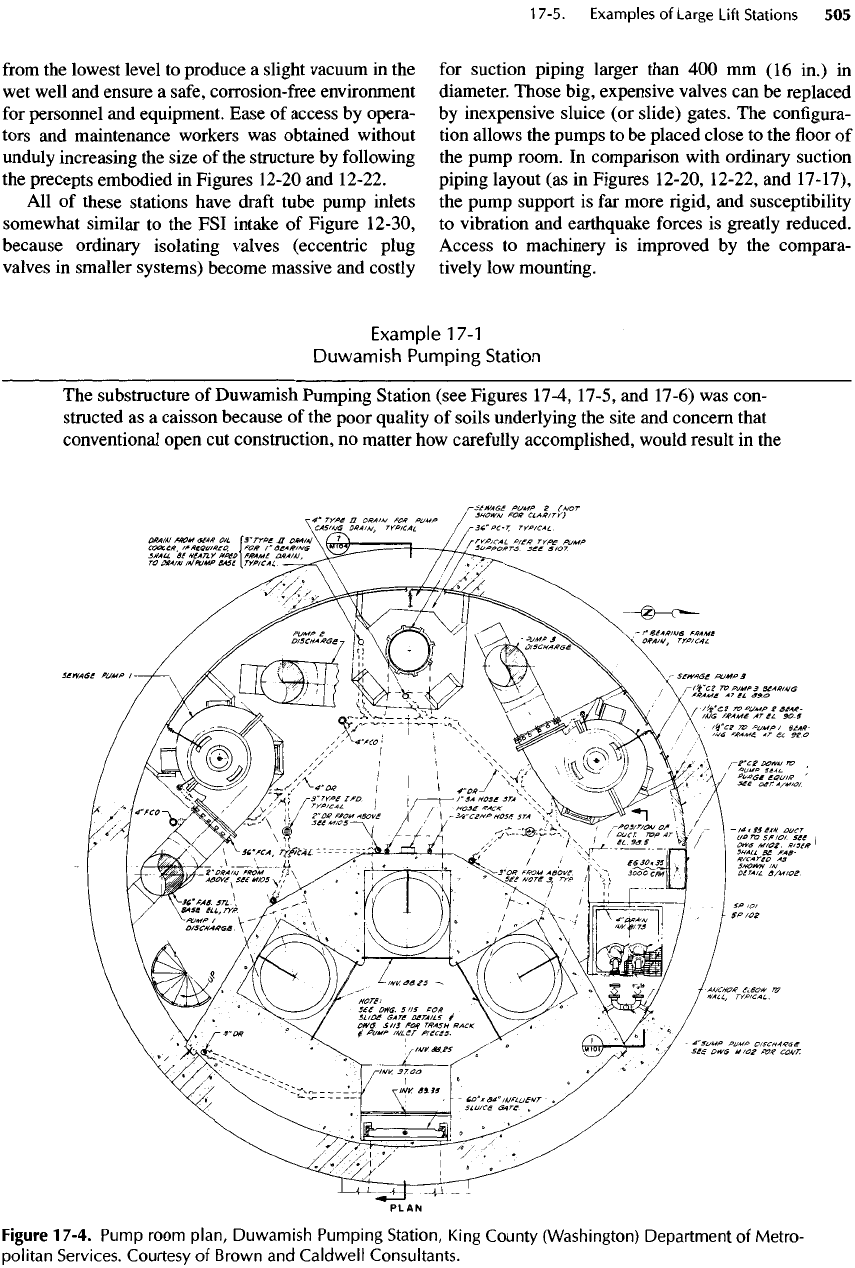
from
the
lowest level
to
produce
a
slight vacuum
in the
wet
well
and
ensure
a
safe,
corrosion-free environment
for
personnel
and
equipment. Ease
of
access
by
opera-
tors
and
maintenance workers
was
obtained without
unduly
increasing
the
size
of the
structure
by
following
the
precepts embodied
in
Figures
12-20
and
12-22.
All of
these stations have
draft
tube pump inlets
somewhat
similar
to the FSI
intake
of
Figure
12-30,
because ordinary isolating valves (eccentric plug
valves
in
smaller systems) become massive
and
costly
for
suction piping larger than
400 mm (16
in.)
in
diameter. Those
big,
expensive valves
can be
replaced
by
inexpensive sluice
(or
slide) gates.
The
configura-
tion allows
the
pumps
to be
placed close
to the floor of
the
pump room.
In
comparison with ordinary suction
piping
layout
(as in
Figures 12-20, 12-22,
and
17-17),
the
pump support
is far
more rigid,
and
susceptibility
to
vibration
and
earthquake forces
is
greatly reduced.
Access
to
machinery
is
improved
by the
compara-
tively
low
mounting.
Example
17-1
Duwamish
Pumping Station
The
substructure
of
Duwamish Pumping Station
(see
Figures
17-4,17-5,
and
17-6)
was
con-
structed
as a
caisson because
of the
poor quality
of
soils underlying
the
site
and
concern that
conventional
open
cut
construction,
no
matter
how
carefully accomplished, would result
in the
Figure
17-4.
Pump room
plan,
Duwamish Pumping Station, King County (Washington) Department
of
Metro-
politan
Services.
Courtesy
of
Brown
and
Caldwell
Consultants.
